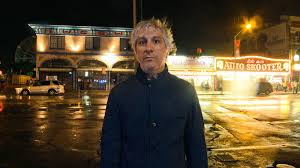Taken By Storm – ‘Lee Ranaldo’s Hurricane Transcriptions’

National Geographic said Hurricane Sandy which hit the east coast of the USA in late October 2012, was “a raging freak of nature that became one of the most destructive storms in U.S. history.” Its surge of nearly 14 feet set a new record for New York harbour.
Amongst the devastation and isolation, guitarist and singer Lee Ranaldo found the urge to create, venturing into the elements to record the sounds of the cataclysm which became Hurricane Transcriptions, what he describes as ” an abstract work based on recording of wind I made on day of Hurricane Sandy, merged with a few songs that are related experiences.”
Commissioned by the Sydney Festival, the Holland festival and stargaze, Ranaldo will be joined by an augmented Ensemble Offspring for the Sydney performance of Hurricane Transcriptions.
Speaking to SoundsLikeSydney from his home in New York, Ranaldo, the founder and former member of Sonic Youth, continued “It’s really a transcription of a weather event; it’s not what you might expect in the way that one thinks of a storm being dramatic, or a Hollywood movie version of a hurricane. It’s simply the transcription of what I heard around me, and it includes things I heard on the street. I worked them into the score because they were on the tape, but mostly it’s a representation of the sound of the winds – shifting tonalities from consonant to dissonant, from dense to thin, from really pretty to really discordant.”
Interspersed with the sounds of the hurricane are three songs that Ranaldo wrote, one of which bears the subtitle to the piece Last Night on Earth. He says “I infused the songs into the piece because I thought it made a nice back and forth narrative, equivalent to what I felt that day being inside my house listening to the storm, and then being outside in the storm recording it – moving back and forth between those two perspectives – one from a more protected secure location and one that was less protected and secure.”
The songs were written in the aftermath of the hurricane, when Ranaldo’s life regressed to a world without electricity, heating, cellphones, computers or running water. Through this, his acoustic guitar still worked and Ranaldo set to work on writing songs by candle light, connected in time and in mood, to Hurricane Transcriptions . Ranaldo explains ” The song called Last Night on Earth is jumping off an event like Hurricane Sandy towards a more sci-fi reading of it. It was a strange week – even though I live in the middle of New York city, it’s very much a neighbourhood and taking a stroll in the evening there were no lights on the street, no lights coming out homes and people looked like ghosts on a shadowy street – it had an apocalyptic feel.”
The concept of the ebb and flow of the storm and the duality of perspective, continues into the combination of voice with the instruments. Ranaldo says “I decided that it would be interesting to integrate some pieces, in song form, with singing, into the work for strings; to have the music ‘flow’ into, and out of, song forms, into, and out of, the storm.” And then there is the other dimension of ensemble and soloist – ” I was also loosely trying to combine the two ideas of me writing for a contemporary music ensemble and the ensemble coming in my direction as well playing a couple of songs with me.”
Hurricane Transcriptions has already had its world premiere at the Holland festival in Amsterdam, in June 2013, performed by the Berlin string ensemble Solistenensemble Kaleidoskop. Ranaldo says he was very pleased with the outcome. “Being the first time it was being presented I had a bit more time than I will have with the ensemble in Sydney. We had about 4-5 days altogether between rehearsing in Berlin and in Amsterdam. It seemed like barely enough but it worked very well.”
Indeed, working with musicians whose framework is ‘classical’ and whose notation is written rather than improvised has been a new frontier for Ranaldo, who was ranked in 2004 by Rolling Stone as number 33 amongst the greatest guitarists of all time. With much of his work based in improvisation, Ranaldo had help with orchestrating his music for the string ensemble. Additionally, the double-edged sword of being a living composer is that he can tweak his writing to suit the available instrumental forces. He explains “It’s mostly scored out in proper notation, but the score was prepared in New York, reworked in Berlin and in Amsterdam and now I’ve been re-working it again here in New York, in preparation for Sydney because we have a different ensemble there – percussion, clarinets and flutes, whereas the stargaze ensemble Solistenensemble Kaleidoskop was a string group, so we’re adapting it again and it’s a work in progress. I’m very happy with the piece and achieving the feeling I wanted from it.”
There are numerous works in the classical music canon which set out to represent forces of nature – Vivaldi’s Four Seasons, Beethoven’s Pastoral Symphony, Sculthorpe’s Kakadu, Messiaen’s Catalogue d’oiseaux. Ranaldo’s work transcribes, rather than re-interprets ,the sounds he heard. Perhaps the most enticing description comes from his own writing: ” Sitting in my loft in lower Manhattan on that day, I could hear the wind coming off, through and around all the tall buildings and making the most amazing sounds: overlapping drones, swirling and repetitive, sometimes sounding like choirs of voices, tonal clusters and harmonies, close and dissonant, but also at times clearly consonant chords with clear root, third and fifth. The city became a massive Aeolian wind harp like the Greeks once made!”
Shamistha de Soysa for SoundsLikeSydney©
Hurricane Transcriptions is presented by the Sydney Festival on Thursday 16th January. Click here for concert information.




